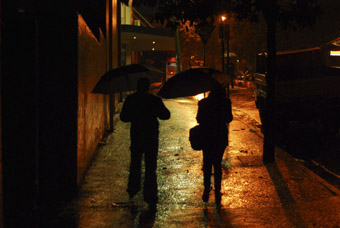time travelling via gps
kate richards: richard fox, razorhurst

Razorhurst participants
photo courtesy d/Lux/MediaArts
Razorhurst participants
IN BARCELONA, A SMALL PLAZA IN THE MOSTLY GENTRIFIED BARRIO GOTHICA HAS BEEN LEFT PURPOSELY UNRENOVATED. THE STONE WALLS ARE HEAVILY POCKMARKED BY GUNSHOTS FROM A FAMOUS BATTLE BETWEEN LOYALISTS AND REPUBLICANS. VISITORS RUN THEIR HANDS OVER THIS EERIE AND VISCERAL REMINDER OF ALL THAT CITIES WITNESS AND ABSORB. YET THE BARRIO GOTHICA HAS ARGUABLY BEEN SAVED BY THE GENTRIFICATION OF ITS LABYRINTHINE ALLEYS. IF THEMED HISTORY PROTECTS AN ENCLAVE, CAN IT BE ALL BAD?
I entertain myself with these thoughts while I wait to play the GPS game Razorhurst in Sydney’s East Village pub. I start writing on the branded beer coaster (nice touch). This once notorious hotel—in my youth The Tradesman’s Arms and a well-known hangout for ‘fences’—is friendly on a Friday night yet retains its patina of criminal mystique. A group of suits discuss tax minimisation, three old blokes with beers are on first-name terms with the barmaid, a tranny and her sidekick cruise by, a paint spattered renovator realising his rendezvous hasn’t materialised reaches for his phone. The original pressed tin ceiling bears witness: if, as JG Ballard imagined, it has absorbed all the sounds that were emitted under its canopy, what stories would it know? What would the original art noveau wall tiles reveal under forensic analysis? I’m clearly ripe for transportation to Depression era Darlinghurst.
Considering the links between the visceral and memory, what role do digital media have in enhancing the powers of historical imagination and in reinvigorating lost histories and spaces? With Razorhurst, presenters dLux/Mobile and creative developer Richard Fox combine urban history with game elements in a GPS-based locative experience. Inducted at the pub, players proceed with GPS enabled handsets and headphones to explore the surrounding streets, collect ‘sly grog’ and fight or join roving groups of razor-wielding gangsters. The content of the game comprises some excellent graphics, stills, movies and audio, both original and archival (sourced from the City of Sydney archives, the Historic Houses Trust NSW and ABC radio drama). The original sound, movies (shot by Mattias Morelos) and graphics have been designed and produced by Fox, and his background as a professional art director hold him in good stead—the overall look and feel are great, from the aforementioned beer coasters to postcards, posters and screen graphics. I liked his voice on the audio, too—a good thing as the experience is heavily audio-based.
The main interface is a GPS-enabled street map, and while this worked well technically, on the night I played I felt that a less heavy reliance on GPS would have benefited the game’s experience design. Using analogue wayfinding and self positioning (eg asking players to orientate to buildings or topography) would lessen the dependence on map reading and allow them to look up at the district. Reliance on location to trigger content, when GPS is quite a coarse grained technology, is also problematic, and possibly a combination of temporally and spatially triggered content would prove more flexible. I would have been happy to have more developed character through-lines and these may be a better direction to pursue than the incorporation of game elements (collecting bottles, losing health to gangsters). The experience straddles themed historical walking tours and games, and as such it must achieve a textured pace. While it succeeds at times (I do literally run from the gangsters), at others I would have preferred dwell-time to stand and hear the narrative more developed.
Overall I found the experience affective. Ever ready to be engaged, I felt that the close-miked audio (perhaps enhanced by unintended looping), the rainy streets and the fast walk around the district darkly familiar to my youth did work to evoke and titillate. I was back in a time when Darlinghurst was not populated by four wheel drives and filled to capacity with so cool-as-to-chill Italian design emporia. I scurry through St Peter’s Lane, run up a back alley to avoid the gangsters racketing in my head, and out of the corner of my eye see layabouts camped on the narrow terrace porches. The brightly lit City Gym reminds me that in the Depression only the fittest survived and muscles were developed hauling fruit boxes down at Paddy’s Markets or wringing wet sheets by hand in some dismal backyard.
Vodka is the new gin and I opt for it over a complimentary gin as my post-game reward. I’m ready to get home and away from thoughts of the many tear-soaked pink gins to which this hotel undoubtedly bore witness.
Razorhurst, designed & developed by Richard Fox, presented by d/Lux/MediaArts, East Village Hotel, Sydney, July 5-31; for full credits see www.razorhurst.com.au
RealTime issue #93 Oct-Nov 2009 pg. 33






